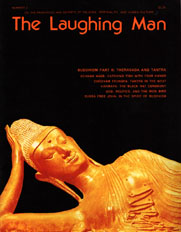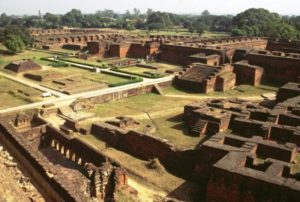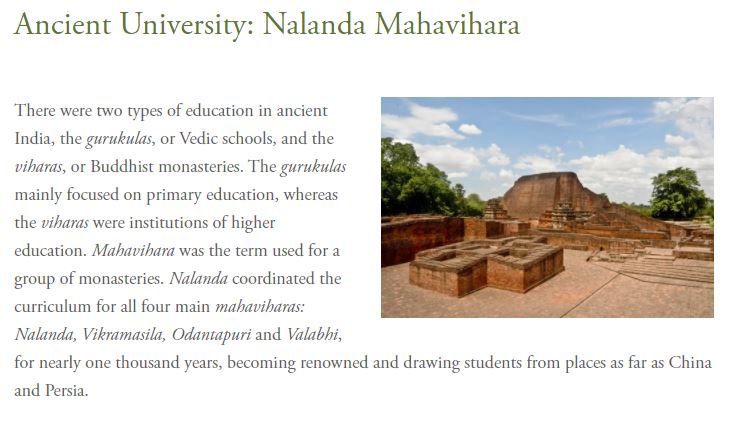Originally published in ‘The Laughing Man’ magazine, Number 2, 1976

NALANDA: The Oxford of Buddhism
by Peter Roberts
“Nalanda University was run with great efficiency, all pervading discipline, and a sense of celebration.”
— Chogyam Trungpa, Rinpoche

Half a day’s drive from Bodhgaya, where Gautama the Buddha was enlightened in 481 B.C., the plains of North India stretch out in seeming exhaustion from the heat. The land is flat and without a sign of it’s former fertility. But this is no ordinary place. Just a few minutes’ walk up a low ridge and you can see a vast expanse of ruins arranged like a checkerboard maze, which used to be the classrooms, libraries and dwellings of over 3000 students and teachers. This was the University of Nalanda, the birthplace and center of Buddhist scholarship in India for over 700 years.
Gautama the Buddha frequently visited the town of Nalanda with his disciples, spending months on end as the guest of a local merchant, during the fifth century B.C. The natural beauty of the place, its proximity to the Ganges, and the constant flow of travelers made it attractive as a resting spot. Perhaps it was for this reason that many legendary saints, philosophers and teachers also frequented Nalanda in an informal way, attracting students and making it a center of learning and debate. In this way, Nalanda gained recognition as a center of spiritual instruction.
So it was only natural that a Gupta king of the fifth century A.D. should choose to build a monastery there, and a whole line of kings after him, until the number of buildings were many, and it was seen that this was indeed a mahavira, or great college (teaching institution). Such a college has no real equivalent in Western culture. Even the word university is only an approximation of mahavira. For, although the student-monks studied and engaged in spiritual practices, these practices, unlike the tradition of Western seminaries, were different depending on the tradition preferred by the monk. And so, even the endowment of Nalanda, which was always provided by royalty, frequently came from kings who were not Buddhists. Simply to give support to the mahavira was an act of spiritual merit, and gifts came from kings from as far away as Bengal, Ceylon, Java, Sumatra, China, Mongolia, Japan, Korea, and Turkestan. So many buildings were added to the original that Nalanda took on the appearance of an enormous, even magical city, surrounded by a single great wall.

The whole establishment was of majestic appearance, with richly adorned towers and fairy-like turrets, the four-storied outside courts, their dragon-like projections and colored eaves, carved and ornamented pearl-red pillars, richly adorned balustrades, and roofs covered with tiles that reflect the light in a thousand shades.
Such was the report of Huien- Tsiang, a great Chinese scholar (and one of the few reliable historians of Nalanda) who visited Nalanda in the sixth century A.D. after a three year pilgrimage through India. He was so impressed with the scholarship and company of the people living there that he stayed for twelve years. He described at least seven “early” colleges at Nalanda, and the libraries were said to be three in number, each one nine stories high.
Nalanda’s prestige was similar to that of Oxford or Harvard, and entrance requirements were high indeed. Students desiring admission must have “studied deeply both Sanskrit and the new [Buddhist] books.” They took their entrance exams at the gate, where learned gatekeepers posed them difficult questions. Only one in ten of those who presented themselves gained admission, and in this way, Nalanda’s reputation as a great monastic university was assured. In fact, Nalanda produced many of the greatest Buddhist scholars of its time. Even great saints were associated with it. Most notable among these was Naropa —illumined teacher of Marpa who then became Guru to Milarepa. Tradition tells us that he served as the Abbot of Nalanda before abandoning his scholarly life to study with the “crazy” wanderer, Tilopa, who, half-clad and ecstatic, later slapped Naropa across the face with his wet sandal, sparking his enlightened realization . . . rather a contrast to the way things were done at Nalanda.
Nalanda was always one of the “best schools,” prestigious, scholarly and even (we are told) happy. This latter quality, in itself, makes Nalanda even more fascinating when you consider the intense study, discipline and attention to detail that was the daily lot of its monks. They lived a physically demanding life, waking at dawn in the cells they shared, bathing outdoors in ponds, and preparing their own food in their rooms from meager ingredients. The rest of the day was devoted to rigorous study of the Buddha Dharma.
Nalanda was not just a place where Buddhism could be comprehended in all its complexity, but also one where different schools of thought within Buddhism and outside it could be considered and a spirit of intellectual self-reflexivity and heterodoxy prevailed. “At its peak it offered an enormous number of subjects in the Buddhist tradition, in a similar way that Oxford (offered) in the Christian tradition—Sanskrit, medicine, public health and economics,” Indian economist and philosopher – Amartya Sen observed in 2010.
In addition to the “old,” pre-Buddhist scriptures (Vedas and Upanishads), the great schools of Buddhist doctrine —Hinayana and Mahayana, Madhyamika and Yogachara —were studied, argued, and mastered by the scholars of Nalanda. In fact, they articulated the full communication of Mahayana Buddhism for the first time. Also, Nalanda was one of the birthplaces of Tantra —a discipline developed fundamentally by scholar monks. Their studies were enlivened by quick-fire debate between teachers and senior students. In fact, this was a principal activity as described by Huien-Tsiang:
The day is not sufficient for the asking and answering of questions. From morning till night they engage in discussion; the old and the young mutually help each other.
Students were known to have spent anywhere from two to twenty years at Nalanda enjoying such a life.
Considered today, eight centuries after its demise, Nalanda University appears amazing. It survived for nearly a thousand years, through all the political, social, cultural, and economic changes within India, as well as all the doctrinal and philosophic changes of Buddhism itself. And throughout all of that, Nalanda was the unrivaled center of learning, the repository for the doctrinal, literary dimension of Buddhism.
Those of conspicuous talent and solid learning, great ability, illustrious virtue —distinguished men — these connect their “high names” with the succession of celebrities belonging to Nalanda such as Dharmapala, Nagarjuna, and still others whose names are lost.
Over the years, however, the teaching of Nalanda became corrupted by magic practices of various kinds. At the same time it fell victim to disastrous attacks by Muslim soldiers. Finally, after a fifty year period of struggling to maintain tradition, Nalanda succumbed to its fate in 1199 A.D. at the hands of Mohammedan invaders:
Mohammed Bakhtiyar with great vigor and audacity rushed in at the gate and gained possession of the place. Great plunder fell into the hands of the victors. Most of the inhabitants were Brahmins with shaven heads. They were put to death. Large numbers of books were found there and when the Mohammedans saw them, they called for some person to explain their contents, but all of the men had been killed.
During its era of prominence, Nalanda had contributed to many Buddhist and even Hindu traditions in Asia. Early institutions of Tibetan Buddhism were modeled on the Indian monastic university, and Nalanda established a tradition of excellence in thought and conduct that informed the great debates and “dharma combat” of almost all Eastern spirituality.
More:
The Buddhist monastery complex at Nalanda, in today’s Indian state of Bihar, was a center of learning founded in the fifth century CE. Archaeological excavations which begun in 1915 has revealed temples, lecture and meditation halls, libraries and gardens, together with a trove of sculptures, coins, seals and inscriptions. Subjects taught here included the Vedas, logic, Sanskrit grammar, medicine, fine arts, astronomy, mathematics, politics and epistemology. Above all, however, it was a center of Buddhist learning which flourished under the Gupta empire, 240-590 CE. [Read more: “Indian mathematics“] Much of our knowledge of Nalanda comes from the writings of Chinese monks who came here to study in the seventh century. At the height of its prominence the university had some 2,000 professors and 10,000 students who all were accommodated in dormitories. Nalanda was the first educational institution to conduct entrance exams. The fortunes of the university declined after the Gupta rulers and in the 1190s it was destroyed by invading armies from Central Asia.
Al Quaraouiyine, in Fez, Morocco, is sometimes said to be the oldest university in the world, founded in 859 CE. [Read more: “Ibn Rushd and the challenge of reason“] The oldest universities in Europe – Paris and Bologna, founded in the thirteenth-century CE – are far younger. Nalanda is older than all of them. However, while Nalanda was destroyed, Al Quaraouiyine has been in continuous operation for close to 1,200 years
